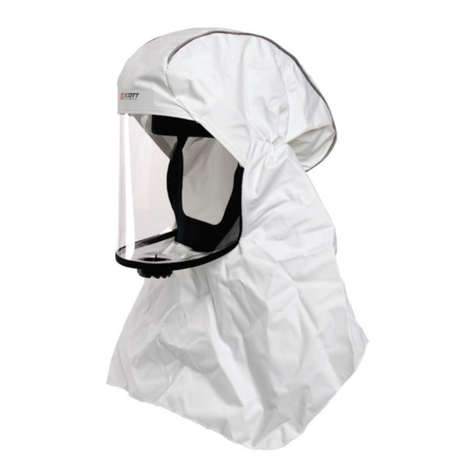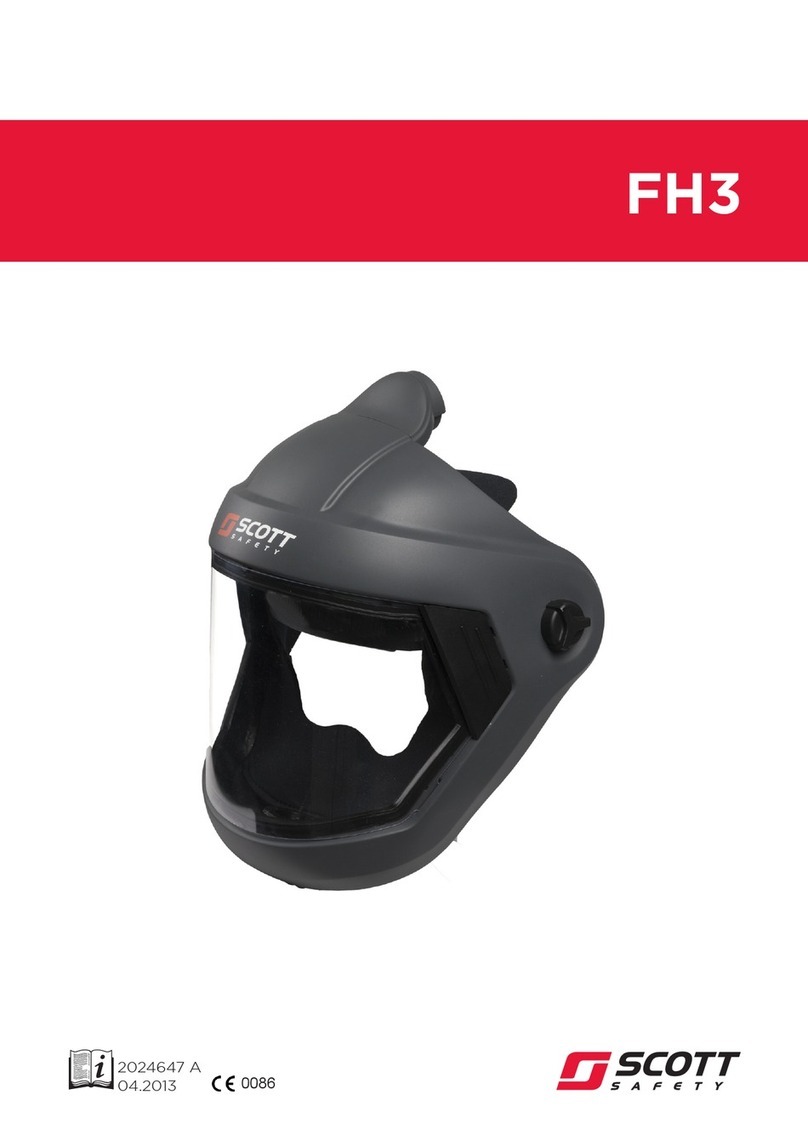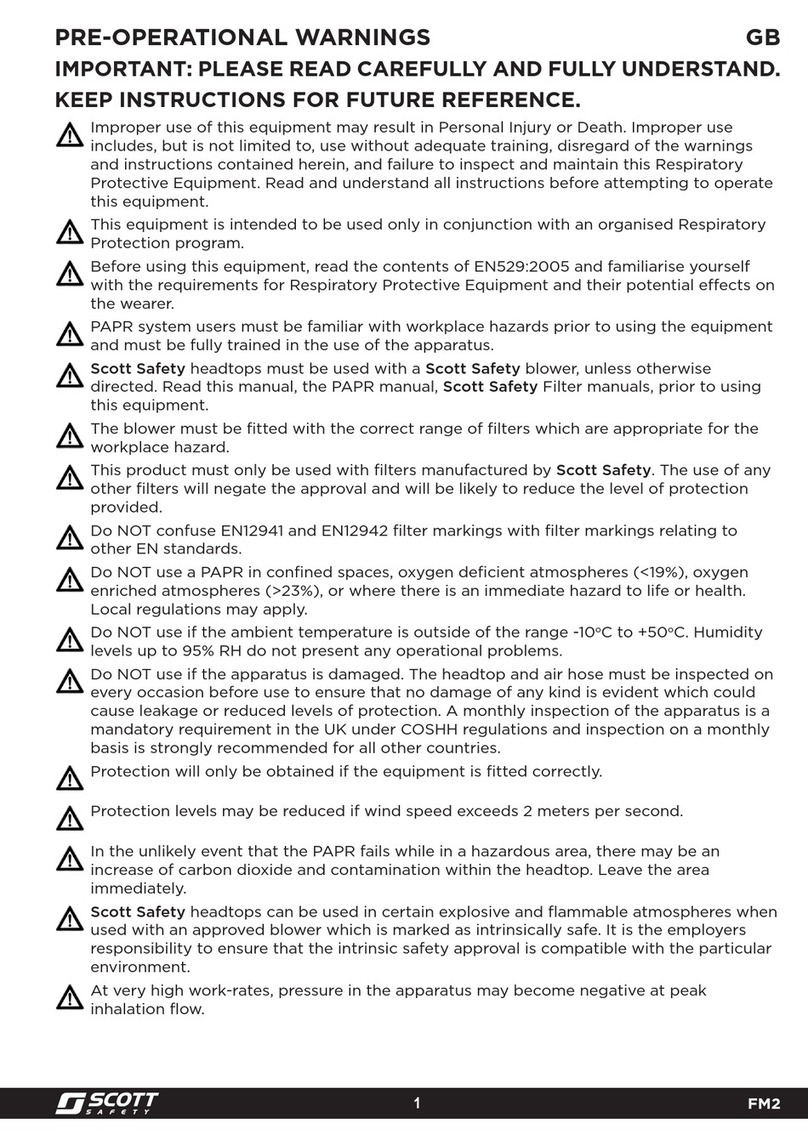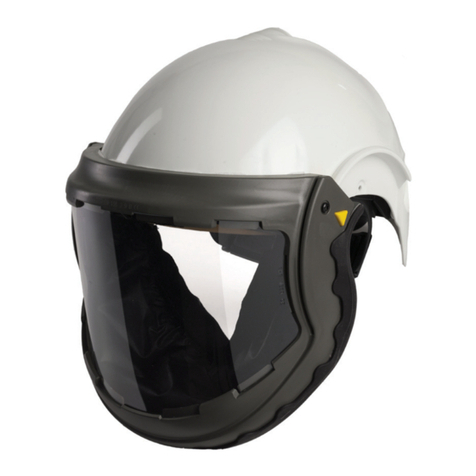
7
FM3
DONNING
When donned correctly the head harness will
be central to the rear of the user’s head and
the mask will sit comfortably on the face with
a good faceseal.
Glasses may not be worn with the FM3 unless
a spectacle frame fitting has been fitted,
for more information contact Scott Safety
Customer Services.
When worn correctly the headtop will be
comfortable and a full range of motion will be
achievable.
• Turn the head harness inside out and
over the front of the headtop
• Offer the mask up to the face with one
hand, chin into the chin cup
• With the other hand pull the harness from
the front of the facemask and over the
back of the Head. Smooth the harness
out ensuring that the head harness does
not ruck or tangle
• Tighten the bottom two buckles, then the
middle two and finally the top buckle
• Test for a good range of motion. The
faceseal should remain in contact with
the face
NOTE
The PAPR must have gone through a
pre-use check in accordance with the
Operating and Maintenance Instructions
manual prior to use.
The breathing hose must be attached to the
blower prior to donning the Headtop - See
Operating and Maintenance Instructions.
DOFFING
• Once free of any hazard switch off the
blower, if attached.
• Ease the lower two head harness
buckles towards the front of the headtop
to fully release the headtop harness
tension
CAUTION
DO NOT REMOVE THE HEADTOP UNTIL
YOU ARE IN A SAFE AND HAZARD
FREE ZONE
AFTER USE CLEANING
• Disconnect the breathing hose from the
blower
• Inspect the equipment for worn or ageing
or damaged components
• Carefully wipe clean the facemask and
with a warm water solution containing a
mild detergent
• It is recommended that headtop visors
be wiped clean with Distel® wipes
• If necessary, wash the outside of
the breathing hose carefully using
warm water solution containing a mild
detergent
• Ensure the breathing hose connections
are free from all dirt or debris that could
prevent an effective seal with the blower
Once clean all components must be left to
dry naturally.
Note
If during use the equipment may have
become contaminated by hazardous
substances, the contamination must
be identifi ed and properly removed or
the contaminated components must be
replaced before next use.
Disposal of the contaminated components
must be carried out in accordance with
local regulatory requirements.
• Pull the head harness over the head and
remove the headtop
• Place the headtop onto a clean surface
• Remove the PAPR in accordance
with the Operating and Maintenance
instructions
• Proceed with after use cleaning and
storage
STORAGE
Once all the components are clean and dry
store in a clean environment.
SPARES
BSI (0086)
Kitemark Court,
Davy Ave,
Knowlhill,
Milton Keynes,
MK5 8PP.
England
Replacement parts and accessories may
be ordered through Scott Safety customer
services. The department can also provide
general information on other Scott Safety
products.
Scott Safety
Pimbo Road, West Pimbo,
Skelmersdale, Lancashire,
WN8 9RA, England
www.scottsafety.com
scott.sales.uk@scottsafety.com
Tel: +44 (0) 1695 711711
Fax: +44 (0) 1695 711775
WARRANTY
The products manufactured at our factories
in Skelmersdale and Vaasa carry a warranty
of 12 months (unless stated otherwise).
This includes parts, labour and return to site
The warranty period runs from the date of
purchase by the end user.
These products are warranted to be free
from defects in materials and workmanship
at the time of delivery. Scott Safety will be
under no liability for any defect arising from
wilful damage, negligence, abnormal working
conditions, failure to follow the original
manufacturer’s instructions, misuse or
unauthorised alteration or repair.
Evidence of purchase date will need to be
produced for any claims arising during the
warranty period. All warranty claims must
be directed through Scott Safety customer
services and in accordance with our sales
return procedure.
NOTIFIED BODIES
MAINTENANCE
Regular and scheduled maintenance is
essential for the integrity of the equipment.
As well as the pre-use and storage checks
the apparatus must be checked on a monthly
basis, a service should be performed annually
by a qualifi ed service and maintenance
operative.
A regular monthly maintenance schedule is
performed as per the pre-use checks which
includes a thorough visual inspection of all
components.
Carry out a thorough inspection of all
component parts before and after each
occasion of use.
Pay particular attention on the headtops to
the exhalation and inhalation valves and the
insertion point of the blower assembly hose.
All O-rings, exhalation and inhalation
valves on this headtop must be replaced
annually regardless of the condition.
In storage, valves have a shelf life of fi ve
years, after which time they should be
discarded.
Exhalation and inhalation valves are marked
with a code indicating the year of manufacture.
The code ‘07’ corresponds to the year 2007
and a dot is added each year thereafter. The
code ‘07•’ (notice the dot after the 7) indicates
the year 2008.
INSPECTION DETAILS
Record test and maintenance details on the
inspection sheet provided at the rear of this
manual.
Information recorded usually includes:
•Name of employer responsible for the
apparatus
• Make, model number or identifi cation
mark of the apparatus, together with a
description of any distinguishing features
•
Date of inspection/maintenance
together with name, signature or unique
identifi cation mark of the examiner
•Condition of the apparatus, details of
any defects found and any remedial
action taken





































